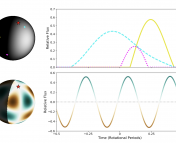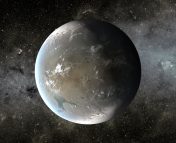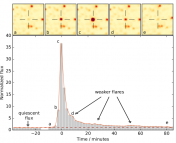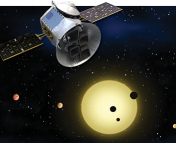Authors: Jonathan J. Fortney, Roxana E. Lupu, Caroline V. Morley, Richard S. Freedman, Callie Hood
First Author’s Institution: Department of Astronomy & Astrophysics, University of California, Santa Cruz
Status: Submitted to ApJ Letters [open access]
Exoplanets transiting or eclipsed by their host stars provide an exciting opportunity to get a spectroscopic view into their atmospheres. Measuring the dip in starlight across different wavelengths as it streams through the atmosphere of a transiting exoplanet (a method commonly known as transmission spectroscopy ) can help us put constraints on the chemical composition and structure of the planet’s atmosphere. Measuring the secondary eclipse (when the planet passes behind the star) on the other hand gives us an estimate of the light emitted and reflected solely by the planet’s atmosphere. Although obtaining the reflected and emission spectrum of an exoplanet this way can be a difficult business, recent space-based secondary eclipse observations have revealed some interesting properties about these atmospheres. Models for interpreting the measured transmission spectra of exoplanets expectedly hinge around the wavelength dependence of the observed radius of the planet. However, calculations for modeling a planet’s flux as measured from its eclipse often involves assuming the planetary radius to be constant, leaving the wavelength dependence solely to the reflected and thermally emitted flux of the planet. The authors of today’s paper investigate the effect such an approximation actually has on calculating the model emission and reflected spectra of exoplanets.
Small and bright, big and dim, and the inverse
In the context of stars, a photosphere refers to its deepest layer visible in a given band of wavelength. Depending on the stellar properties (like gravity and metallicity) which affect the scattering of light in the stellar atmospheres, the depth to which you can see inside a star, and hence it’s observed brightness temperature and size, would vary with respect to the observed wavelength. The daysides of exoplanets when observed during secondary eclipse should also exhibit a similar effect. For a planetary atmosphere where temperature increases with depth: at wavelengths which are less absorbed or scattered by the atmosphere, you would be able to look deeper into the atmosphere, and the planet would appear brighter but also physically smaller. By the same logic for wavelengths which do not probe as deeply, it would appear dimmer and bigger. This weighting of the planet’s flux due to the wavelength dependence of its radius can significantly modulate its observed emission and reflected spectrum. The authors include this in their calculations of the emission spectrum of planet Kepler-51b as an example (see Figure 1) and demonstrate that this photospheric variation of the planetary radius changes the emission spectrum at both high and low resolution by up to 200 %!

Figure 1: (Left) Comparison of models of Kepler-51b’s dayside spectrum when considering wavelength dependent and constant planet radius. (Right) Ratio of the two models at low (R=250) and high (R=2500) resolution – notice that the two spectra disagree by up to 200 %.
In the case of a thermally inverted (temperature decreasing with depth) atmosphere, the effect of the wavelength dependence of the photospheric radius is reversed as the planet appears bigger in brighter wavelengths which see higher up in the atmosphere, and smaller in dimmer wavelengths. The strength of this effect is not limited to only hot Jupiters, and can become significant for planetary atmospheres with relatively large pressure scale heights — essentially planets with puffed up atmospheres.
The authors point out that in most general cases though, and for the best precision observations possible with current instruments, the constant radius assumption may be quite reasonable and shouldn’t affect the model comparison for current near-infrared secondary eclipse observations much. However, as we prepare for exquisite, high precision secondary eclipse observations from the James Webb Space Telescope coming up soon, this effect would become more relevant and it would be imperative to take it into account to compute accurate models. In addition to the photospheric radius effect discussed by the authors, it would also be important to account for other subtle physical effects like stellar surface inhomogeneities when interpreting the spectroscopic observations of exoplanet atmospheres.




